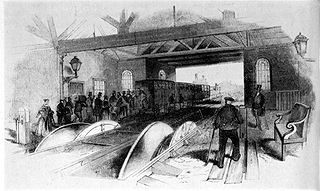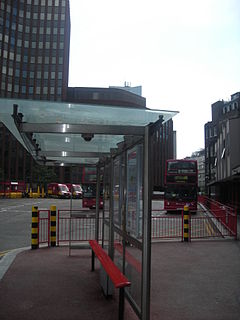
The Northern line is a London Underground line that runs from south-west to north-west London, with two branches through central London and three in north London. It runs northwards from its southern terminus at Morden in the borough of Merton to Kennington in Southwark, where it divides into two central branches, one via Charing Cross in the West End and the other via Bank in the City. The central branches re-join at Camden Town where the line again divides into two branches, one to High Barnet and the other to Edgware in the borough of Barnet. The High Barnet branch has an additional single-station spur at Finchley Central with a shuttle train to Mill Hill East.

Fenchurch Street railway station, also known as London Fenchurch Street, is a central London railway terminus in the southeastern corner of the City of London. It takes its name from its proximity to Fenchurch Street, a key thoroughfare in the City. The station and all trains are operated by c2c. Services run on lines built by the London and Blackwall Railway (L&BR) and the London, Tilbury and Southend Railway (LTSR) to destinations in east London and south Essex, including Upminster, Grays, Basildon, Southend and Shoeburyness.

Cannon Street is a road in the City of London, the historic nucleus of London and its modern financial centre. It runs roughly parallel with the River Thames, about 250 metres (820 ft) north of it, in the south of the City.

Minories is the name of a former civil parish, also known as Minories Holy Trinity, and a street in the City of London, close to the Tower of London.
Originally called the Commercial Railway, the London and Blackwall Railway (L&BR) in east London, England, ran from Minories to Blackwall via Stepney, with a branch line to the Isle of Dogs, connecting central London to many of London's docks. It was operational from 1840 until 1926 and 1968, closing after the decline of inner London's docks. Much of its infrastructure was reused as part of the Docklands Light Railway. The L&BR was leased by the Great Eastern Railway in 1866, but remained independent until absorbed into the London and North Eastern Railway at the 1923 Grouping.

Fenchurch Street is a street in London linking Aldgate at its eastern end with Lombard Street and Gracechurch Street in the west. It is a well-known thoroughfare in the City of London financial district and is the site of many corporate offices and headquarters. The name "Fenchurch" derives from the Latin faenum (hay) and referred to hay markets in the area.

Ludgate Hill was a railway station in the City of London that was opened on 1 June 1865 by the London, Chatham and Dover Railway (LC&DR) as its City terminus. It was situated on Ludgate Viaduct between Queen Victoria Street and Ludgate Hill, slightly north of St. Paul's station on the site of the former Fleet Prison.

Corporation Street is a main shopping street in Birmingham city centre, England. It runs from the law courts at its northern end to the centre of New Street at its southern.

Minories was the western terminus of the London and Blackwall Railway (L&BR), located on the east side of Minories, a short distance north-east of the Tower of London. The line was operated on a cable-hauled basis with a 400 hp pair of stationary steam engines winding a cable 7 miles (11 km) long, to which the trains were attached on the cable car principle.

St. Martin's Le Grand is a former liberty within the City of London, and is the name of a street north of Newgate Street and Cheapside and south of Aldersgate Street. It forms the southernmost section of the A1 road.

Lime Street is a minor road in the City of London between Fenchurch Street to the south and Leadenhall Street to the north. Its name comes from the lime burners who once sold lime from there for use in construction.
Wellclose Square is a public square in the London Borough of Tower Hamlets, between Cable Street to the north and The Highway to the south.

Holy Trinity, Minories, was a Church of England parish church outside the eastern boundaries of the City of London, but within the Liberties of the Tower of London. The liberty was incorporated in the Metropolitan Borough of Stepney in 1899, and today is within the City of London. Converted from the chapel of a nunnery, Holy Trinity was in use as a church from the 16th century until the end of the 19th century. It survived as a parish hall until it was destroyed by bombing during World War II.

Aldgate bus station serves the Aldgate area of the City of London, England. The station is owned and maintained by Transport for London and located directly south of Aldgate tube station.

Bouverie Street is a street in the City of London, off Fleet Street, which once was the home of some of Britain's most widely circulated newspapers as well as the Whitefriars Priory.

Crosswall is a street in the City of London.

Savage Gardens is a minor street in the City of London, connecting Crutched Friars in the north to Trinity Square in the south, crossing Pepys Street. It was part-pedestrianised in 2011, with the carriageway remaining between Pepys Street and Trinity Square.

Pepys Street is a street in the City of London, linking Seething Lane in the west to Cooper's Row in the east. Savage Gardens crosses the street.

The Crescent was a part-completed, Regency-style terrace in central Birmingham, England, first proposed in 1788, started and discontinued in 1795, and finally demolished in the mid- to late 1960s. Like other late 18th and early 19th century crescent terraces in Britain and Ireland, it took its inspiration from The Crescent, Bath, designed by John Wood the Younger and built 1767 to 1774.


















